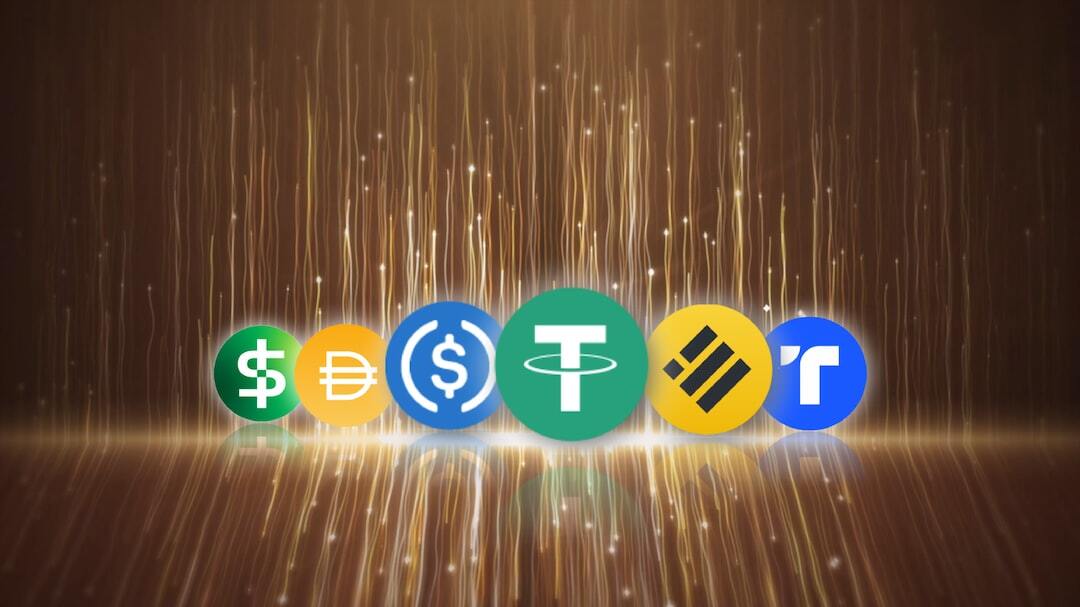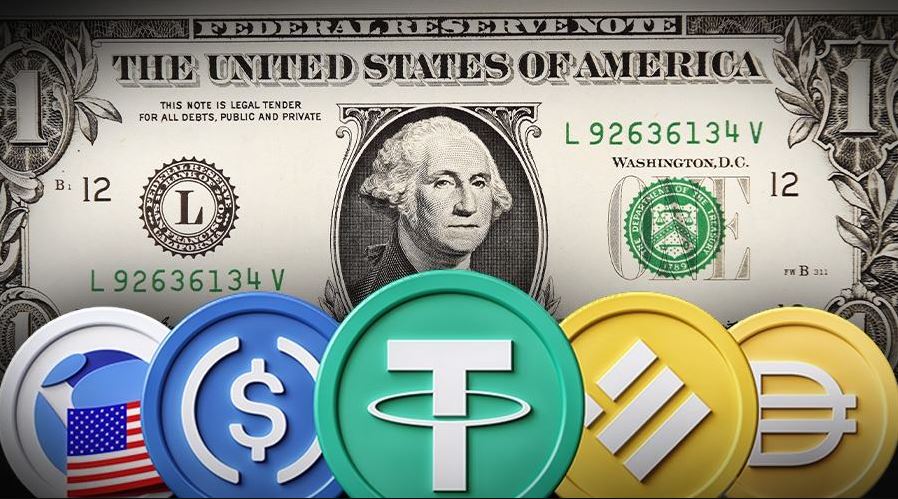In cryptocurrency, there is a need for crypto assets with a stable value and a stable exchange rate. This is why stablecoin issuers introduced them. In this article, we will take a look at different types of stablecoins and how they work. Stay tuned!
What is a Stablecoin?
Stablecoins, representing a bridge or a fusion of digital assets and traditional finance. A stablecoin is a cryptocurrency designed to minimize the volatility often seen in assets like Bitcoin (BTC) or Ethereum (ETH). How? By having a stablecoin pegged to more stable assets for example the US dollar, or other fiat currencies, gold or even cryptocurrencies.
They designed to keep a stable price and let users avoid the volatility. So basically we have the security and transparency of blockchain technology, paired with the stability of well-known currencies.
How Do Stablecoins Work?
Every stablecoins are backed by a collateral, something that gives it value, like a fiat currency, commodities, or even other cryptocurrencies. When you purchase a stablecoin, you’re basically buying a token that represents a claim on its underlying asset. Imagine them as traditional banknotes – representing a claim to a certain amount of gold.
To maintain their peg to the underlying asset, stablecoins using smart contracts, incentives, and financial mechanisms. Smart contracts, which are self-executing contracts with the agreement directly written into the code, play a very important role. These contracts grants that the number of tokens in circulation matches the amount of collateral held in reserve.
Some stablecoins have mechanisms to influence demand and supply. For example, if the price of a stablecoin starts to drift away from its peg, these mechanisms can either incentivize users to buy more tokens or sell their tokens, helping to restore the balance.

Transparency is another key point of how stablecoins operates. To earn the trust from users, many stablecoin projects regularly undergo audits to verify that the amount of collateral they claim to have in reserve exists.
Types of Stablecoins
We can talk about three different types of stablecoins, depending on whats behind the stablecoin. Perhaps the two most obvious are the fiat-backed and the crypto-backed stablecoin, but there is another type of stablecoin — the algorithmic. Lets take a look at them and try to understand what is the difference between these tokens.
Fiat-Backed Stablecoin
These stablecoins are perhaps the most straightforward type of stablecoins and probably the most easier to understand. Their value is tied directly to a reserve of traditional money, like the US Dollar.
For every fiat-backed stablecoin issued, there’s an equivalent amount of fiat currency held in reserve. This means if there are 1 million stablecoins in circulation, there should be 1 million USD (or another fiat) held in a bank account or in a vault. This one-to-one peg is the basis of price stability.
When someone wants to purchase a fiat-backed stablecoin, they pay the same amount money but in fiat currency. This amount then gets added to the reserve, and the stablecoin is issued to the buyer. Just to make sure you understand let me give you another explanation — when someone wants to or “cash out” their stablecoin, they return the token, and in exchange, they receive the exact amount but in fiat currency, which is then deducted from the reserve.
Since the value of fiat-backed stablecoins based on the assurance that for every token in circulation, there’s an equivalent amount of fiat currency in reserve, we need to mention how transparency becomes a really important factor. That is why regulators often seek to regulate the stablecoin issuers. Most of these stablecoins audited regularly by a third-party to verify and that the reserves match the circulating supply of tokens.
These stablecoins are also serves as bridge between the digital and traditional financial world. They offer the advantages of cryptocurrencies, like fast transactions and global money transfers.
Crypto-Backed Stablecoin
These type of stablecoins are similiar as fiat-backed stablecoin, which rely on traditional currencies, crypto-backed stablecoins are paired to other digital assets, typically more volatile cryptocurrencies like Ethereum.
The fundamentals behind crypto-backed stablecoins is the so-called over-collateralization. This means that for every stablecoin issued, there’s more than its worth held in a reserve of another cryptocurrency. For example, to obtain $100 worth of a crypto-backed stablecoin, one might need to deposit $150 worth of Ethereum. This extra collateral making sure that even if the value of the stablecoins experiences price volatility, the tokens prices remains stable.
Smart contracts are the engines behind crypto-backed stablecoins. These self-executing contracts, with terms of agreement directly coded into them, ensure that the system remains transparent and operates as it has to. They automatically manage the issuance, redemption, and liquidation processes, making sure that the system remains solvent. Some of them work under Decentralized Autonomous Organizations (DAOs), where users has the right to suggest alterations to the initiative. This means, you have option to “vote” on the entity for optimal choices.
When someone wishes to issue and supply crypto-backed stablecoins, they lock up a certain amount of another cryptocurrency in a smart contract. In return, they receive the corresponding amount of stablecoins. When they decide to redeem, they return the stablecoins, and the smart contract releases the original cryptocurrency back to them, after accounting for any fluctuations in value.
The advantage of these type of stablecoin is decentralization so not like fiat-backed coins. Fiat-bacled tokens rely on banks or centralized entities to hold reserves, crypto-backed versions operate within the blockchain ecosystem. Moreover, they offer transparency, as all transactions and collateral amounts are recorded on the blockchain, available for anyone to verify.
However these coins having challenges as well. The primary problem is the price volatility of the underlying collateral. If the cryptocurrency used as collateral experiences a significant decline in value, it could trigger liquidations and potentially destabilise the stablecoin price.
Algorithmic Stablecoin
Algorithmic stablecoins are a type of tokens that use software algorithms and smart contract mechanisms to automatically adjust their supply, aiming to stabilize their price.
The model behind these tokens is the ability to automatically increase or decrease the total supply of the coin based on market demand. When the price of the stablecoin is above the target price (e.g., $1), the algorithm issues more coins to increase the supply, aiming to bring the price down. Conversely, when the price is below the peg, the algorithm reduces the supply, often by allowing holders to buy bonds that promise future coins, with the goal of pushing the price back up.
These coins operate without the need for collateral. This means they don’t rely on reserves of fiat currency, other cryptocurrencies, or any other assets to back their value. Instead, the model lies on the ground of stability from the trust that the algorithm will function as intended and market participants will act rationally.
The primary benefit is their decentralized nature, free from reliance on any form of collateral. This makes them highly scalable, as they can be issued without the need of backing assets. They promise a more organic stabilization mechanism, driven by algorithmic adjustments.
We need to mention, however these systems are still in their early stages, and their long-term viability remains a topic of debate within the crypto community.
Popular Stablecoins
Now we will explore some of the most popular stablecoins, including Tether (USDT), USD Coin (USDC), and Luna (Terra). Where Tether and USD Coin are fiat-backed, while Luna is algorithmic and PAXG are commodity-backed stablecoins with gold.

Tether (USDT)
The fiat-backed stablecoin called Tether, or USDT, was one of the first stablecoins. Launched in 2014, it was created to hold a 1:1 peg to the US dollar. At the time of writing the market capitalization of Tether is $86,115,121,402 according to Coinmarketcap.
The concept behind Tether was simple: provide a digital representation of traditional money while using the benefits of blockchain technology. It quickly gained popularity as it made a lot easier for traders and investors to work with their crypto assets.
Tether’s history hasn’t been without controversy. Bitfinex (issuer of the stablecoin), one of the biggest crypto exchange, is closely associated with Tether. In 2019, the New York Attorney General’s office accused Bitfinex of using Tether’s reserves to cover up losses, leading to legal action. While Tether maintained that it had always been fully backed, this incident raised concerns about the transparency and regulatory compliance of stablecoins.
In 2021, Tether reached a settlement with the U.S. Securities and Exchange Commission (SEC) over allegations of misrepresenting the backing of its stablecoin. As part of the settlement, Tether agreed to provide more transparency about its reserves.
USD Coin (USDC)
USD Coin, or USDC, is another stablecoin that was launched in 2018 by the company called Circle. USDC is known for its strict regulatory compliance and transparency standards. USDC is issued by regulated financial institutions and is subject to regular audits to make sure that its reserves are equivalent to the number of avaible USDC tokens.
In 2021, USDC faced a scary problem when its price temporarily dropped to $0.91 on Coinbase after Silicon Valley Bank collapsed and Circle revealed that the company had 3.3 billion exposure with the Bank. This deviation from its 1:1 peg to the US dollar raised concerns within the crypto community and people started to panic selling their USDC. However, it was solved and communicated well by Circle and USDC regained its stability. Important to mention that USDC is audited by U.S. accounting firm Grant Thornton LLP every month.
Currently the market cap of USDC stablecoin in circulation is $24,408,276,169.
The Collapse of Luna and its Stablecoin Terra
Luna is known as a popular token linked to the Terra blockchain network, co-founded by Do Kwon and Daniel Shin in 2018. TerraUSD (UST) was an algorithmic stablecoin, maintaining its value through a mechanism linked to its sister token, Luna. Luna served multiple functions within the Terra network, including paying transaction fees, maintaining the UST’s peg to the dollar, and participating in the network’s governance.
The price of Luna risen from under $1 to $116, turning many investors into millionaires within just one year. This rise was fueled in part by the 20% annual yield offered on the Anchor lending platform for staking UST — a rate many analysts warned was unsustainable.
UST came into question when, in May 2022, a massive un-staking of UST from Anchor triggered a catastrophic de-pegging from the dollar. As UST’s value plummeted, the protocol automatically minted more Luna to counterbalance the loss, leading to hyperinflation of the Luna token and its eventual crash to near zero value. This event shook the crypto world, delisting Luna from exchanges and erasing fortunes overnight.
The aftermath of the Luna crash obviously had heavy consequences, with an estimated $300 billion wiped off the crypto market, triggering bankruptcies and financial distress for many investors. Meanwhile, Do Kwon proposed a recovery plan, but it was too late. The launch of Luna 2.0 did little to nothing with the damage. Legal troubles soon followed for Kwon, with a South Korean court issuing an arrest warrant for alleged violations of market laws.
Featured image source: financemagnates




